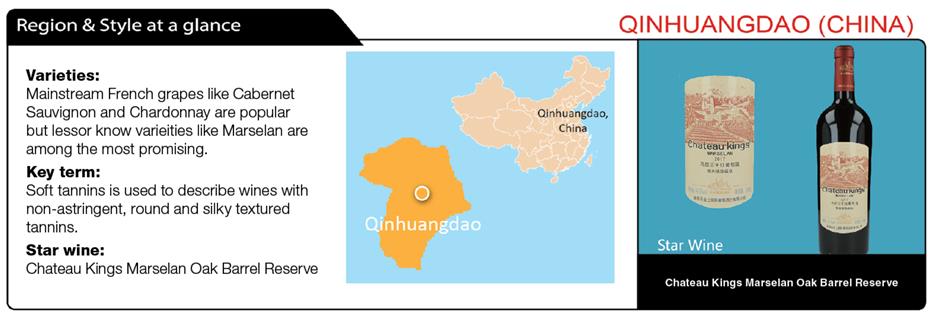A rosy outlook for China's wines

Vineyards in Qinhuangdao, in northern Hebei Province, benefit from proximity to the mountains and the sea.
When my friends at Shanghai Daily asked me to write about 2020 wine trends in China, I was determined to set an optimistic tone. After all, no one wants more doom and gloom. Checking with wine industry experts throughout China, I soon realized my optimism was shared.
First I’ll serve up some insights from two leading wine importers, starting with Alberto Camuso, Shanghai manager for Interprocom.
“In 2020, the market became more sophisticated and eclectic, and consumers are identifying their own personalities to wine varieties or denominations; like, ‘I’m Pinot Noir, I’m Pinot Grigio and so on,’” said Camuso. Self-identification with certain styles and type is both a fascinating and promising aspect.
“We noticed strong growth for organic, biodynamic natural wines in 2020,” said Vincent Simon, marketing director for China Wine and Spirits. “The trend started years ago, but has been consolidating in 2020. This wave is apparent in Shanghai and other first-tier cities like Beijing, Chengdu, Guangzhou and Shenzhen.”
“This year was also good for top Italian and Northern Rhone wines as consumers expanded their horizons from more established regions,” added Simon.
One of the most experienced and astute observers of the China market is Jim Sun, the founder and editor-in-chief of winechina.com. For two decades, this website has been a valuable resource for Chinese and international wine news and analysis. Asked about 2020, he said: “Wine is more popular, including families drinking at home who are attracted to good value, easy-drinking fruity wines that are not especially complex, like lighter red wines.”
Sun also emphasized the growing importance of large and small digital wine shops. But one of his points particularly resonated with me: “Chinese wines are becoming more popular, particularly during the epidemic. Chinese wines were more convenient to source. Both casual family drinkers and dedicated wine lovers are gravitating toward China wines.”
My focus this week will be on the enthralling advancement of domestic wines. In years past, the number of high-quality domestically produced wines were far fewer than today, and my extensive international travels permitted me little time to visit Chinese wine regions and learn. All that changed in 2020.
Unable and undesiring to travel abroad, this year I traveled instead to several of China’s most promising regions. Last week I was in one of China’s oldest and most prestigious.

In many ways the saga of Qinhuangdao in Hebei Province as a wine region reminds me of the tale of the phoenix rising. Ancient eastern and western cultures from China to Greece and Egypt all shared myths of the majestic beast. In many of these tales the phoenix symbolizes renewal and resurrection, something quite apropos for Qinhuangdao where talented winemakers are making some of China best and most distinctive wines.
Qinhuangdao is one of China’s oldest wine regions. The region made the nation’s first dry red wine and the beneficial influences of the Bohai Sea and mountains are ideal for winemaking.
But a decade ago a scandal involving adulterated wine damaged the region’s image. However, scandals have happened in many famous wine regions; so the real story is about the rebirth of Qinhuangdao as a premier wine region. This is an inspiring tale that parallels the rising of the phoenix. The winery I visited last week is a big part of the region’s present success and promising future.
Designed in post-modern architecture, Chateau Kings is one of region’s most important producers. The expansive winery boasts the world’s largest wine-themed murals as well as state of the art wine production, tasting and tourism facilities.
In many ways Chateau Kings is more than just a winery, it’s a viticulture history and culture center as well as a gourmet and health resort.
The sovereign variety at Chateau Kings is Marselan. The Marselan hybrid Cabernet Sauvignon and Grenache variety was created in southern France in 1961 by professor Paul Truel. Marselan wines tend to be deeply colored with good fruitiness and soft tannins, characteristics popular with Chinese drinkers.
The grape is resistance to powdery mildew, so it performs well in humid regions like Qinhuangdao. Although a creation of France, the Marselana I’ve tasted from Qinhuangdao and other Chinese regions are decidedly superior to their French counterparts.
Since the first vintage in 2015, the Chateau Kings Marselan Oak Barrel Reserve and Marselan Oak Barrel Collection wines have won 43 awards including gold medals at top international wine competitions.
Both wines are exemplar China Marselans wines featuring deep ruby red colors, elegant and expressive red and dark fruit aromas with intriguing mint and chocolate notes, elegant silky tannins and impressively long finishes. Chateau Kings also produces a charmingly bright and fresh limited-edition dry white blend of Chardonnay, Italian Riesling and Petit Manseng.
Other recommended Qinhuangdao producers with available in Shanghai include Kweichow Moutai Changli Winery, COFCO Greatwall Chateau Huaxia and Bodega Langes.
There’re so many positive developments in Qinhuangdao and other top regions that when the clock strikes midnight for New Year, I shall raise my glass and make a New Near’s resolution to learn about the beautiful wines of China.















